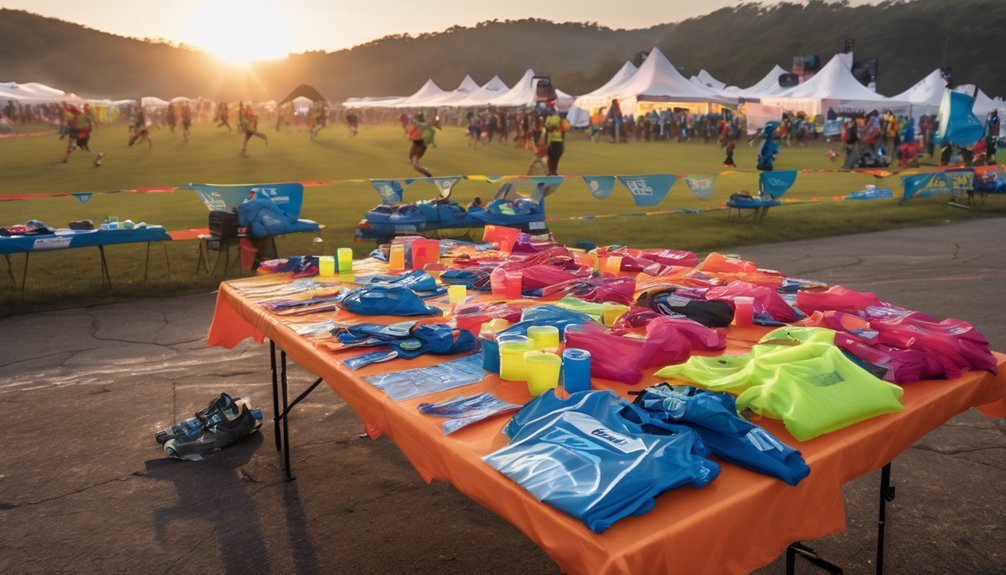
Preparing for a cross-country event involves more than just logging miles. You need to understand the course, including its elevation changes and challenging terrain. A well-structured training plan is crucial, but so is nutrition and mental readiness. Each aspect plays a vital role in your overall performance. As you gear up for race day, consider how these elements intertwine to shape your success. What strategies will you implement to ensure you're fully prepared?
Key Takeaways
- Familiarize yourself with the course layout and terrain to strategize effectively for elevation changes and obstacles.
- Build a varied training plan that includes long runs, speed work, and hill training while allowing for rest days.
- Focus on nutrition by timing meals appropriately and ensuring a balance of carbs and protein for recovery.
- Choose the right gear, including supportive footwear and moisture-wicking clothing, to adapt to weather conditions.
- Practice mental strategies like visualization and positive affirmations to enhance confidence and reduce race-day anxiety.
Understand the Course

Before you lace up your shoes and hit the trail, it's crucial to understand the course you'll be tackling in the cross-country event. Familiarizing yourself with the course elevation is key; steep hills can drain your energy, while flat stretches may offer a chance to recover.
Assessing terrain features, like rocky paths or muddy spots, helps you anticipate challenges and plan your strategy. Consider how these elements impact your pace and endurance.
Visualize the course layout, and think about how to tackle each section effectively. By doing this, you'll not only feel more prepared but also more connected to your fellow runners who share the same journey.
Understanding the course can instill confidence and foster a sense of belonging in the cross-country community.
Build a Training Plan
Creating a solid training plan is essential for excelling in a cross-country event. Start by assessing your current fitness level and setting realistic goals.
Incorporate varied training intensities—mix long runs, speed work, and hill training to build endurance and strength. Remember, schedule flexibility is vital; life can throw curveballs, so be prepared to adjust your plan without losing sight of your objectives.
Include rest days to allow your body to recover, preventing burnout and injuries. Engaging in group runs can also enhance motivation and foster a sense of community.
As you progress, track your improvements and adjust your training intensity accordingly. With dedication and a well-structured plan, you'll feel confident and ready to tackle the course.
Focus on Nutrition
As you build your training plan, don't overlook the impact of nutrition on your performance. Proper meal timing is crucial; fueling your body before and after runs can enhance your energy levels and recovery. Aim to eat a balanced meal rich in carbohydrates and protein about 1-3 hours before training sessions.
Post-run, refuel with a mix of carbs and protein to repair muscles.
Hydration strategies are equally vital. Staying hydrated helps maintain your stamina during long runs. Drink water consistently throughout the day, and consider electrolyte drinks for intense efforts.
Listen to your body's signals, adjusting your intake based on your needs. When you prioritize nutrition, you not only support your training but also create a strong foundation for race day success.
Choose the Right Gear

Selecting the right gear can significantly influence your performance and comfort during a cross-country event. Start with proper footwear; your shoes should provide adequate support and traction based on the terrain.
Consider gear selection carefully—look for moisture-wicking fabrics that keep you dry, especially in unpredictable weather. Layering is key; it allows you to adapt to changing conditions without overheating or getting too cold.
Don't overlook accessories like gloves, hats, and sunglasses, which can enhance your experience.
Always factor in weather considerations; rainy or windy days require more durable gear, while sunny weather might call for lighter clothing.
Practice Mental Strategies
While physical preparation is crucial for a successful cross-country event, honing your mental strategies can make a significant difference in your performance.
Start by incorporating visualization techniques into your training routine. Picture yourself navigating the course, feeling the rhythm of your breath, and crossing the finish line with confidence. This mental imagery can boost your focus and reduce anxiety.
Additionally, practice positive affirmations daily. Remind yourself of your strengths and abilities, like "I'm strong enough to tackle any challenge." These affirmations cultivate a growth mindset, reinforcing your belief in your capabilities.
Prioritize Recovery
To excel in a cross-country event, you can't overlook the importance of recovery, which plays a vital role in your overall performance.
Prioritizing recovery techniques can make a significant difference in how you feel and perform. After your race, don't rush off; instead, focus on post-race routines that help your body heal. Stretching, hydration, and nutrition are key elements.
Incorporate foam rolling and light jogging to alleviate soreness and improve blood flow. Additionally, consider incorporating rest days into your training schedule to boost recovery.
Prepare for Race Day

As you gear up for race day, understanding the key elements of your preparation can set you up for success.
Start with a thorough race day checklist to ensure you don't forget essential items like your racing shoes, bib number, and hydration gear. Pay attention to weather considerations, as they can significantly impact your performance. If it's hot, dress in lightweight, breathable fabrics; if it's chilly or wet, layer appropriately.
Arrive early to warm up and soak in the atmosphere—this builds camaraderie with fellow racers.
Finally, trust your training and visualize your race strategy to calm any nerves. Embrace the excitement, knowing you're part of a community that shares your passion for cross-country racing.
You've got this!
Frequently Asked Questions
How Do I Choose the Right Footwear for Cross-Country Events?
Choosing the right footwear involves understanding shoe types like trail runners or spikes. Focus on fit considerations, ensuring comfort and support, so you can confidently tackle any terrain and feel part of the running community.
What Should I Do if I Encounter Bad Weather on Race Day?
When the skies darken, don't panic. Equip yourself with weather gear to stay dry. Adjust your race strategy; focus on pacing and staying steady. Embrace the challenge, and remember, every runner faces unpredictable elements.
How Can I Improve My Pacing During the Race?
To improve your pacing during the race, practice pacing strategies through race simulations. Focus on maintaining a steady tempo, adjusting your speed according to terrain, and listening to your body for optimal performance and endurance.
What Are Common Injuries to Watch for During Training?
When training, you've gotta be alert for common injuries. Shin splints can sneak up on you, and knee pain might escalate if you ignore early signs. Stay proactive to keep enjoying your runs with friends.
How Can I Stay Motivated Throughout My Training Program?
To stay motivated during training, focus on goal setting and celebrate small achievements. Use positive reinforcement to reward yourself, creating a supportive environment that fosters connection and encourages you to keep pushing forward toward your goals.
Conclusion
As you lace up for your cross-country event, remember that preparation is your compass, guiding you through the twists and turns ahead. By understanding the course, honing your training plan, and fueling your body, you're setting a strong foundation. Embrace the mental strategies that will elevate your confidence, just like a well-tuned engine powering a race car. With recovery and the right gear in place, you're ready to tackle race day and unleash your full potential on the course.





